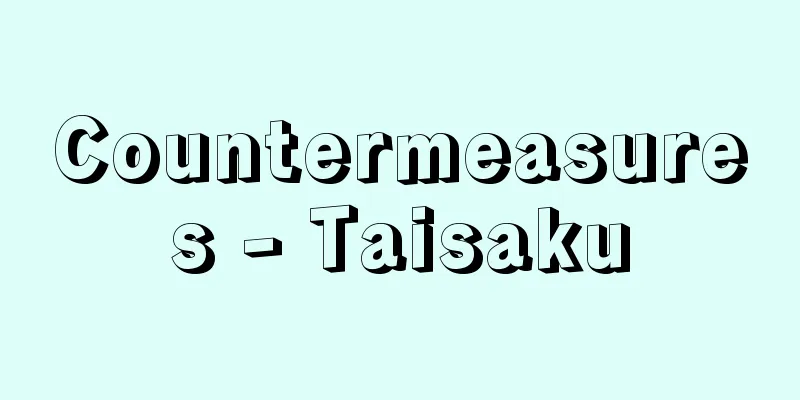Nagakubo Sekisui

|
Year of death: July 23, 1801 (August 31, 1801) Year of birth: November 6, 2nd year of Kyoho (December 8, 1717) A mapmaker from the mid-Edo period, and a Confucian scholar of peasant origin. Born in Akahama Village, Hitachi Province (Takahagi City). Commonly known as Gengobei, his given name was Genju, his pen name was Kotama, and his pen name Sekisui was a pen name. He studied Chinese classics under Suzuki Matsue, a local doctor, and Etsu Nankei, a Confucian scholar of the Mito domain. A trip to Nagasaki in 1767 (Meiwa 4), in which he accompanied a domain official as a representative of the village headman to retrieve some castaways from nearby villages who had returned from Annam (Vietnam), greatly stimulated his desire to write. The results of this journey include "Nagasaki Gyōyaku Nikki" (1805), "Annam Hyōryū-ki" (manuscript), and "Seisa Sōwa-shū" (a collection of Chinese poetry exchanged with people from the Qing Dynasty, 1892). The Revised Map of Fuso Districts of Japan, published in the 5th year of the same year, was based on a map of Japan with longitude and latitude lines by Mori Yukiyasu, which he had apparently obtained in Osaka, and a revised version of this, the Revised Map of Japan's Land Routes, was published in 1779 by an Osaka publisher. It was the first published map of Japan with longitude and latitude lines, and enjoyed favorable reviews until the end of the Edo period. In the 6th year of the same year, on the recommendation of the county magistrates, he was appointed tutor to the lord of Mito domain and stationed in Edo. After his retirement in 1791, he remained in Edo and devoted himself to writing the geography section of the Dai Nihonshi, but for the Dai Nihonshi that was completed in 1906, Kurita Hiroshi's draft ("Kokugunshi") was used, rather than Sekisui's. Other works that had a great influence on later generations include "Earth's World, Mountains, Seas, and Lands, Complete Maps" (Matteo Ricci series, around 1788), "Tang Dynasty Provinces and Counties, History Maps" (the first colored historical atlas, 1790), and published works include "Tenmon Kankisho" (1774), "Daiqing Guangyu Tu" (1785), "Tohoku Kiko" (1792), and others. <References> Sugita Ujin, "Nagakubo Sekisui"; "Nagakubo Sekisui" edited by the Ibaraki Prefecture Local Culture Research Association (Umino Kazutaka) Source: Asahi Japanese Historical Biography: Asahi Shimbun Publications Inc. About Asahi Japanese Historical Biography |
|
没年:享和1.7.23(1801.8.31) 生年:享保2.11.6(1717.12.8) 江戸中期の地図作者,農民出身の儒者。常陸国赤浜村(高萩市)生まれ。通称源五兵衛,名は玄珠,字は子玉,赤水は号。郷医鈴木松江,水戸藩儒名越南渓に漢学を学ぶ。安南(ベトナム)から帰国した近村の漂流民の身柄引き取りのため,庄屋代理として藩吏と共に赴いた明和4(1767)年の長崎への旅は,彼の著述意欲を大きく刺激した。『長崎行役日記』(1805),『安南漂流記』(写本),『清槎唱和集』(清国人との応酬漢詩集,1892)はその産物である。同5年の『改製日本扶桑分里図』は大坂で入手したらしい森幸安の経緯線記入日本図に基づいており,これを改訂した『改正日本輿地路程全図』は安永8(1779)年大坂の版元から出版された。刊本としては最初の経緯線記入日本図であり,幕末まで好評を博した。同6年郡奉行らの推薦により水戸藩主の侍講に任ぜられ江戸詰となった。寛政3(1791)年の退職後も江戸に留まって『大日本史』地理志の執筆に没頭したが,明治39(1906)年完成の『大日本史』には赤水のではなく栗田寛 の稿(「国郡志」)が採用された。そのほか,後世への影響が大であった彼の作品には,『地球万国山海輿地全図説』(マテオ・リッチ系,1788頃),『唐土歴代州郡沿革地図』(彩色歴史地図帳の嚆失,1790)があり,刊本の著作には『天文管窺鈔』(1774),『大清広輿図』(1785),『東奥紀行』(1792)その他がある。<参考文献>杉田雨人『長久保赤水』,茨城県郷土文化研究会編『長久保赤水』 (海野一隆) 出典 朝日日本歴史人物事典:(株)朝日新聞出版朝日日本歴史人物事典について 情報 |
<<: Boring machine (English: Nakaguriban)
>>: Nagakute [town] - Nagakute
Recommend
Ortag (English spelling)
…Ortāg, a Muslim loan shark guild that was active...
Advanced conversion reactor - Shingata Tenkanro
A type of nuclear reactor. Among thermal neutron ...
Kuhn, Abraham
…From the late 19th century to the early 20th cen...
Sweet potato
...With his unique writing style that goes one st...
Karton - karton (English spelling) cartoon English
It is a cardboard, but in terms of painting mater...
Vserossiiskaya assotsiatsiya proletarskikh pisatelei
…Its official name is the Russian Association of ...
S-Suku - S-Suku
…The oldest carvings, of elephants and hippos, ar...
Takehara Salt Fields
The Irihama salt fields were built in Takehara, Ak...
Junzo Ohashi
⇒ Ohashi Totsuan Source: Kodansha Digital Japanese...
epigram
(1) epigramma A type of poetry in ancient Greece a...
Echegaray - José Echegaray (English spelling)
Spanish playwright. After achieving success as a ...
Gold Market - Kinshijo
The gold bullion market is a market in which the p...
Fish Hawk - Uotaka
〘Noun〙 (Based on the fact that it likes to catch a...
Abd Allah (Ismaili) - Abd Allah
...After Ismail's death, a group of people wh...
Mikasayama
Also written as Mikasayama. A mountain in the east...









